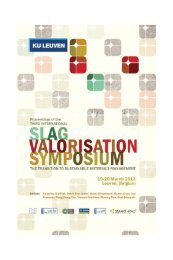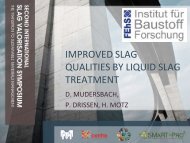International Slag Valorisation SymposiumLeuven6-7/4/2009 - Third ...
International Slag Valorisation SymposiumLeuven6-7/4/2009 - Third ...
International Slag Valorisation SymposiumLeuven6-7/4/2009 - Third ...
You also want an ePaper? Increase the reach of your titles
YUMPU automatically turns print PDFs into web optimized ePapers that Google loves.
Characterisation of leaching processes<br />
The pH-dependent leaching characteristics of both the fresh and carbonated steel slag<br />
samples were determined in a pH-stat system. Eight suspensions of a slag sample and<br />
Nanopure-demineralised water, at an initial liquid to solid (L/S) ratio of 10 L/kg, were<br />
stirred for 48 h in closed Teflon reaction vessels at room temperature. For seven vessels,<br />
the pH was controlled automatically ± 0.2 pH units around a pre-set pH-value (pH = 2-<br />
12.5) by the addition of 1 or 5 M HNO3 and 1 M NaOH. For one vessel, the pH was not<br />
adjusted and leaching was performed at the native pH of the sample. After 48 h, the pH<br />
and redox potential of the suspensions were determined and the suspensions were<br />
filtered through 0.2 µm filters.<br />
Column leaching (percolation) tests were performed according to CEN/TS 14405. The<br />
steel slag was added to a borosilicate glass column (inner diameter 5 cm) in layers of a<br />
few cm and packed by shaking and pushing gently with a rod to a filling height of ± 20<br />
cm. Nanopure demineralised water was used as the leachant. The packed columns were<br />
water-saturated and pre-equilibrated for 72 hours, as prescribed by CEN/TS 14405, after<br />
which the influent was pumped in up-flow direction. Computer-controlled flow<br />
controllers assured a constant flow velocity during the experiments. Fractions were<br />
collected automatically at cumulative L/S values of 0.1, 0.2, 0.5, 1, 2, 5 and 10 (l/kg).<br />
Effluent fractions were collected in acid-cleaned PE bottles. Shortly after collection of<br />
each effluent fraction, pH, redox potential (Eh) and conductivity were determined, and<br />
sub-samples for chemical analysis were taken and filtered through 0.45 µm membrane<br />
filters.<br />
The filtered leachates from the pH-stat and column experiments were analysd for a large<br />
number of major and trace elements. 1,3)<br />
Geochemical Modelling<br />
Geochemical modelling was performed on pH-stat leachates and process water samples<br />
from the carbonation experiments to identify the leaching processes. Details of the<br />
model set up in the geochemical modelling framework ORCHESTRA, considering<br />
aqueous speciation, mineral dissolution/precipitation and sorption processes, are<br />
provided by Huijgen & Comans. 3) Selective chemical extractions were performed on the<br />
fresh and carbonated pH-stat samples to obtain model input parameters for the amounts<br />
of reactive amorphous and crystalline Al-, Fe- and Mn-(hydr)oxide minerals in the steel<br />
slag matrix, which were considered to potentially control sorption processes. 3) The<br />
element concentrations in the leachates were modelled over the entire pH range. For all<br />
sorbates except Mo, the measured concentration at pH = 2 was taken as an estimate of<br />
their availability (i.e., the maximum fraction of an element that can be leached), since it<br />
was assumed that the available element fraction is completely leached at this pH. For<br />
(anionic) Mo, the highest concentration was measured at alkaline pH-range and taken as<br />
1 st <strong>International</strong> <strong>Slag</strong> <strong>Valorisation</strong> Symposium│Leuven│6-7/4/<strong>2009</strong><br />
42







